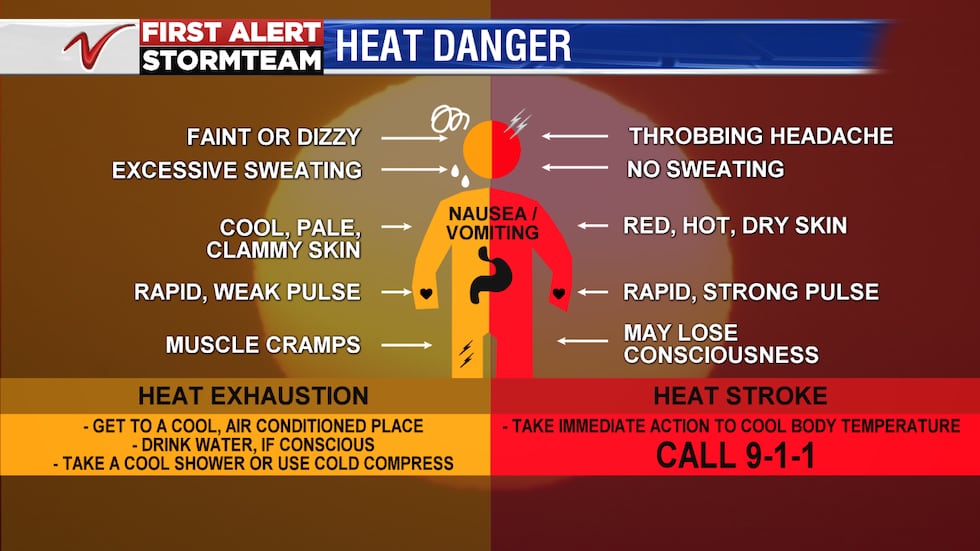Health Department Issues Heat Advisory: Stay Safe During High Temperatures

Table of Contents
Recognizing Heat-Related Illnesses
Knowing the signs and symptoms of heat-related illnesses is the first step in staying safe during a heat advisory. Early recognition is key to preventing serious complications.
Heat Exhaustion
Heat exhaustion is a milder form of heat-related illness, but it's important to recognize it early to prevent it from progressing to heat stroke. Symptoms include:
- Heavy sweating
- Weakness
- Dizziness
- Headache
- Nausea
- Muscle cramps
What to do if you suspect heat exhaustion: Get to a cool place immediately. Rest, rehydrate with water or an electrolyte drink, and remove any excess clothing. If symptoms persist or worsen, seek medical attention.
Heat Stroke
Heat stroke is a life-threatening medical emergency. Symptoms include:
- High body temperature (above 103°F or 39.4°C)
- Confusion
- Seizures
- Loss of consciousness
- Rapid, weak pulse
- Rapid breathing
- Red, hot, and dry skin (though sometimes skin may be moist)
What to do if you suspect heat stroke: Call emergency services (911) immediately. This is a time-sensitive situation requiring immediate medical attention. While waiting for help, move the person to a cool place and try to lower their body temperature with cool water or ice packs.
Heat Rash
Heat rash, also known as prickly heat, is a skin irritation caused by excessive sweating. It's characterized by:
- Red bumps
- Itching
- Prickling sensation
Preventing and treating heat rash: Keep your skin clean and dry. Wear loose, lightweight clothing. Cool showers or baths can provide relief.
Protecting Yourself During a Heat Advisory
Staying safe during a heat advisory requires proactive measures. Here are some essential steps you can take:
Stay Hydrated
Hydration is crucial during periods of extreme heat. Drink plenty of water throughout the day, even before you feel thirsty. Avoid sugary drinks and alcohol, as they can actually dehydrate you.
- Carry a reusable water bottle with you at all times.
- Consider electrolyte drinks if you're engaging in strenuous activity.
- Eat fruits and vegetables with high water content like watermelon and cucumbers.
Limit Outdoor Activities
Reduce strenuous outdoor activities, especially during the hottest parts of the day (typically between 10 a.m. and 4 p.m.).
- Schedule outdoor activities for early mornings or evenings when temperatures are cooler.
- Take frequent breaks in the shade or air conditioning. Never leave children or pets unattended in a parked vehicle.
Wear Appropriate Clothing
Wear lightweight, light-colored, and loose-fitting clothing to reflect the sun's rays and allow for better air circulation.
- Wear a wide-brimmed hat to shade your face and neck.
- Apply sunscreen with an SPF of 30 or higher to protect your skin from sunburn.
Check on Vulnerable Populations
Elderly individuals, young children, and those with chronic illnesses are more susceptible to heat-related illnesses. Check on them regularly.
- Regularly check on neighbors, family members, and friends who might need assistance.
- Offer help with staying cool and hydrated.
Finding Relief from the Heat
When the temperatures soar, finding ways to cool down is essential.
Seek Air Conditioning
Spend time in air-conditioned environments if your home lacks adequate cooling. This could include:
- Libraries
- Shopping malls
- Community centers
- Public cooling centers (check with your local authorities for locations)
Use fans strategically to improve air circulation.
Cool Showers or Baths
Take cool showers or baths to lower your body temperature.
- Apply cool compresses to your wrists, neck, and ankles.
- Avoid very cold water, which can cause shock.
Conclusion
Staying safe during a heat advisory requires proactive measures and awareness of heat-related illnesses. By following these tips and taking precautions, you can significantly reduce your risk. Remember to stay hydrated, limit your time outdoors during peak heat hours, wear appropriate clothing, and check on vulnerable individuals. Heeding this heat advisory and taking preventative steps will help keep you and your community safe. Stay informed about updates regarding the heat advisory from your local Health Department. Your health and safety are paramount during this period of extreme heat. Remember to check your local news and the Health Department's website for updates on the heat advisory and any potential extensions.

Featured Posts
-
 Large Scale Police Operation At Mosque Linked To Muslim Mega City Development
May 13, 2025
Large Scale Police Operation At Mosque Linked To Muslim Mega City Development
May 13, 2025 -
 1 050 Price Hike At And T Details The Impact Of Broadcoms V Mware Deal
May 13, 2025
1 050 Price Hike At And T Details The Impact Of Broadcoms V Mware Deal
May 13, 2025 -
 Assessing The Effects Of Low Mortgage Rates On The Canadian Housing Market
May 13, 2025
Assessing The Effects Of Low Mortgage Rates On The Canadian Housing Market
May 13, 2025 -
 Ostapenkos Upset Victory Stuttgart Triumph Over Sabalenka
May 13, 2025
Ostapenkos Upset Victory Stuttgart Triumph Over Sabalenka
May 13, 2025 -
 Pegula Falls To Sabalenka In Miami Open Final
May 13, 2025
Pegula Falls To Sabalenka In Miami Open Final
May 13, 2025
